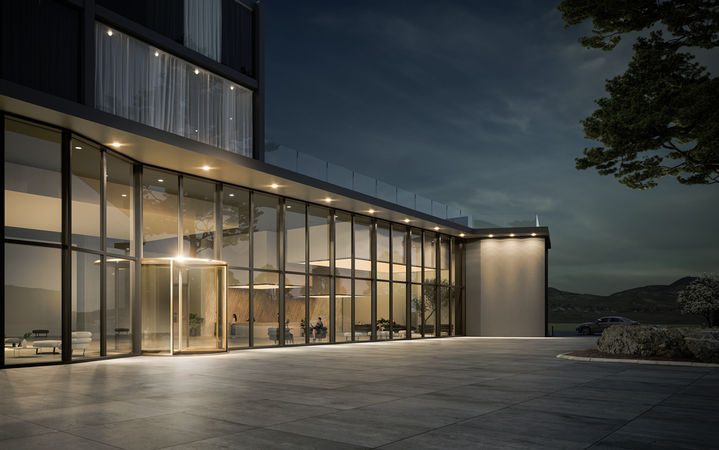Entrance areas – planning challenges and solutions
Proper planning of entrance areas is a challenge for planners and architects. All concepts need to take into consideration not only the requests and ideas of the client, but also all statutory requirements for fire protection, escape routes or accessibility. Dipl.-Ing.(FH) and freelance architect Erik Schaufelberger and Thomas Lehnert, Business Solutions Manager at GEZE tell us which solutions can be used to meet these and other challenges.
What are the typical challenges that planners and architects face when planning entrance areas?

Among other sectors, freelance architect, Erik Schaufelberger, develops buildings for commercial construction, assisted accommodation and care homes. © GEZE GmbH
Erik Schaufelberger: First of all, during planning, we always have to ask ourselves: How will the building be used? Will it be open around the clock, or only during certain hours? How many people will use the entrance area each day? Will these people come all at once, or spread out throughout the day?
Thomas Lehnert: Right - because you can decide about the most suitable type of door only based on the number of people and the flow of traffic If 500 people get off a train at once, for instance, and want to go outside through a revolving door, then that won’t work. In this case, you need a sliding door or at least an automatic swing door. It is also important to know who will be using the building. Children or people with walkers, wheelchairs and other physical restrictions have special needs when it comes to accessibility. Or, if the door is also used to bring in goods, if shipping services are bringing in bulky deliveries, the door needs to be of a certain size. Another aspect are escape routes.
Escape routes and accessibility are regulated by law, and are often highly complex. What solutions are available in these areas?
Thomas Lehnert: In general, all of our doors – swing doors, sliding doors or revolving doors – conform to statutory regulations. However, there are doors and door systems that are more or less suitable. In addition to the user groups and projected customer flows, planners also have to take legal regulations and the specifications of local building authorities into consideration. The break-out variants of our revolving doors, for instance, meet escape route requirements. Despite this, they only have a general suitability; a statement of approval for use in the building must be obtained from the local building authority.
Erik Schaufelberger: Accessibility is a major issue for our clients, who often come from the public sector. We almost always need to ensure that enough area for them to move is available, and ways for individuals with physical restrictions and their aids, like wheelchairs or walkers, to be able to operate and use the doors. A revolving door eliminates the need for a vestibule, and can be combined with a swing door to meet accessibility requirements.
Accessibility is a major issue for our clients, who often come from the public sector.
Erik Schaufelberger, freelance architect, Dipl.-Ing.(FH)
With a low ceiling canopy and narrow profile, for excellent design. © GEZE GmbH
Do revolving doors have advantages in terms of sustainability and energy efficiency in buildings?
Thomas Lehnert: Absolutely. Our Revo.PRIME, for instance, is especially energy-saving thanks to the latest drive technology. It consumes around 30 per cent less energy compared to the previous model. However, in general we can say that revolving doors add sustainability. They keep direct access between the indoors and outdoors closed. This means there is no heat exchange when a user enters or leaves the building. In contrast to other doors, no vestibule is needed in this case. There is no draught, and dirt, wind, noise, and the like stay outdoors. At the same time, these aspects add comfort to the entrance area. However, due to the curved glass that is used they have a worse U-value; although this does not have much of an effect on the overall assessment of the façades of large buildings. The area of a revolving door compared to the area of the entire façade is relatively small, maybe 1 or 2 per cent. The comparatively poor U-value of the door, therefore, has very little impact, and the effect of the door on the total U-value is extremely slight.
Erik Schaufelberger: That is true. The law stipulates limit values that apply to the closed building envelope. However, doors are there so you can go through them. So in my way of thinking the issue of U-values only makes sense to a limited extent. Nevertheless, a revolving door is better able to limit heat loss from the inside to the outside than a swing door or a sliding door with a vestibule.

Despite its size and weight, the new Revo.PRIME has sustainable energy requirements. © GEZE GmbH
If planners want to, or need to build energy efficient-buildings, would you recommend a revolving door like the Revo.PRIME? Or would another door system make sense?
Thomas Lehnert: There is no one-size-fits-all answer to the question; you always need to take the use of the building into account. A revolving door always makes sense in case of high access frequency, because the rotational movement and partition between the inside and outside can significantly reduce energy loss in the entrance area. There is no other door system that compares; this is simply the major advantage of a revolving door. However, it doesn’t make sense if it is going to be used five times a day. In this case, we recommend a simple – and inexpensive – swing door. But for a high-traffic shopping centre, hotel or office building, a revolving door is significantly more energy efficient. The Revo.PRIME is also particularly sustainable in terms of the amount of energy the door itself uses. Thanks to its new drive technology, it uses approximatively the same amount of energy as a sliding door, despite its size and the heavy turnstile.
When it comes to customer flow: What factors typically play a role?
Thomas Lehnert: You have to choose the right type of door depending on the focus. If people are coming from the side, for instance, a revolving door needs to be turned somewhat so that its opening matches their trajectory and the safety sensors aren’t being triggered constantly. If there is already a door installed but it is not optimal for the situation, for instance, not at the best angle, then there are ways to solve the problem: You may need to adjust the sensors. Alternatively, you could also install a swing door beside the revolving door to resolve bottlenecks, if the on-site situation allows.
Revolving doors always offer added sustainability. They keep direct access between the indoors and outdoors closed. This means there is no heat exchange when a user enters or leaves the building.
Thomas Lehnert, Business Solutions Manager at GEZE
Thomas Lehnert, Business Solutions Manager at GEZE, is our expert on revolving doors. © GEZE GmbH
Safety sensors are useful and necessary devices. But let’s be honest, it's annoying when doors are always open even though no one’s using them.
Thomas Lehnert: That’s true. Unfortunately, this often happens because the sensors are not set correctly, or are set improperly for the usage situation. Our new Revo.PRIME can solve this problem as well. It has a high torque of 1,000 nanometers. This helps the door to stop quickly and powerfully – and start up again that way as well. The advantage: This allows the sensors to be adjusted so that they have a small detection area. This is an advantage in particular when large groups of people are using the door, since the sensors will not trigger as quickly. If the door does stop, the Revo.PRIME continues to turn so as not to interfere with the customer flow once the person has left the sensor range once again. This makes the door run more fluidly, more quickly, and tends to result in fewer unintended stops. It is also equipped with new laser-based sensors with technology that is less susceptible to faults because it is not impacted by moisture, solar radiation or substrates. In general, this makes operation less subject to errors.
What is the process for choosing a product? When should experts on entrance situations be consulted?
Erik Schaufelberger: Which product should be used, and in which size, are factors that are decided relatively late following the building approval. In addition, only components we had in the plan in service phase 2 or 3 are installed. This then usually makes it into phase 5, the implementation planning, and in execution. In reality, the decision of what is installed depends on what we design: If we think a revolving door is the right choice in an area, it is important to present this recommendation to the building owner in the draft planning stage.
Thomas Lehnert: That would also be the right time to consult experts like ours at GEZE: Once the first draft, the first idea for the building exists. Unfortunately, we often only come into the picture at the end, once a decision on the door system has already been made. In this case we cannot offer much advice, but rather only optimise the installation situation and sensor settings. Therefore, it is best to involve us even before the call for tenders is created or published. I can only recommend that planners and architects get advice from experts early on, and take advantage of our experience and competence!



